· 12 min read
How Rage of Bahamut Monetizes
Michail Katkoff
Product Manager at Supercell
This third post from Michail Katkoff, game analytics expert and friend of GameAnalytics, puts the spotlight on Rage of Bahmut – a game of contrasts. Michail explains how this game can effectively monetize players, while otherwise being bland, annoying and lacking polish.
When Rage of Bahamut (from DeNA’s publisher Mobage) conquered the top grossing charts on iOS and Android I was stunned. I just couldn’t understand how this web port with no sound, with sexist anime graphics and absolutely terrible player flows makes any money. I asked my gaming colleagues around the world and none of them understood why people play this game. After a few tries, I uninstalled the game thinking that this was one of those one hit wonders. A Gangnam Style of gaming.
Then came Marvel: War of Heroes, Hell Fire, Blood Brothers and other card (or collecting) games from Mobage that continued the success. It was time to give these games a proper shot. After a month of daily sessions, I believe that I now understand the 8 core mechanics which make these games successful.
The Core Loop
The core loop of Mobage’s card games is pretty straightforward. It comprises of two main elements – Single Player Mode (PvE) and Player Versus Player Mode (PvP). Both game modes have their own specific energies, ensuring that one mode adds onto the other, instead of cannibalizing from it. Most of the images below are from Marvel: War of Heroes, which is essentially Rage of Bahmut’s reskin.
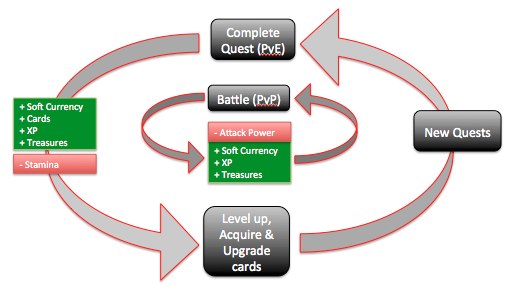
The Single Player Mode
The single player campaign may not look like much. Actually it looks downright awful. But the mechanics are simply amazing! Basically, what happens is a series of 9 taps onto the screen of your mobile device, which contain elements from action, casino, collecting and role-playing games – a series of actions that you keep on repeating several sessions a day and that always feel more and more engaging and entertaining.
Here’s the flow. You open up the mission view, tap on the screen and see an enemy going down with a blow after each tap (Action). After three taps and three enemies down, a treasure chest will appear asking you to tap to open it (Casino). Fourth tap is executed to open the chest and see a new card added into you collection (Collecting). Then you’re back to the mission mode. One more tap and you’ve completed the mission. Completing mission rewards player with an attribute point (RPG), which can be used to increase one of the three: maximum PvP Energy, maximum PvE Energy and maximum Defense Power.
The PvE mode is wrapped around a super simple story line to keep the tapping meaningful and structured. A set of missions is called a campaign and each campaign ends in a boss battle, after which a new campaign with new enemies and new quest givers is presented. So, apart from being extremely engaging, the PvE mode is also the best way to level up, get Soft Currency and earn new cards early in the game.
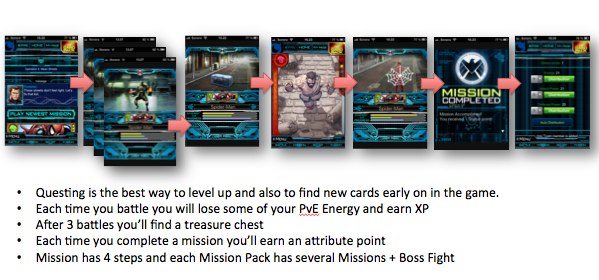
Player versus Player Mode
In the beginning, challenging other players is the only thing players can do. Battles are asynchronous and the attacker first choses opponents based on their level, resources or rivalry. Then the chosen attacker’s attack pack (5 cards) are put against the defender’s defensive card pack of five cards. After a few seconds and a very simple animation, the initiating player is declared either a winner or a loser.
Each PvP battle consumes PvP Energy based on how powerful the cards used by the player are. Winning a battle earns players Soft Currency and card-specific XP. Losing, on the other hand, simply leaves the player empty-handed and without any PvP Energy. As the player progresses, the game’s focus will shift from PvP towards looting specific Treasures and towards guild wars. Both will be further detailed in this post.
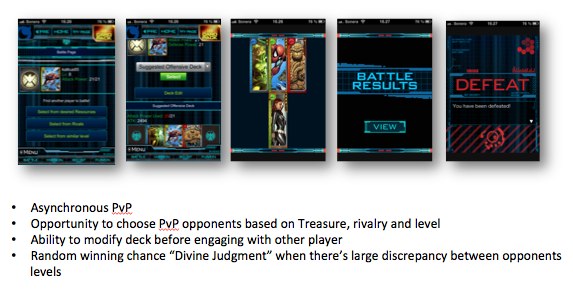
The Eight Core Elements of Success
1. Simplicity
I think 99% of you will argue that this game can be described as simple. And in a way, you’re right. The game features text instructions, a terrible UI and the absolutely worst user flows I’ve ever experienced in a mobile game. Yet again, once you’ve gotten into the game, leveled up few times, beaten bosses and earned a few of the first cards, there’s just no simpler and more satisfying game sessions.
The application is light on the battery, there are no skill elements, sessions are super short, replayable and ultra rewarding. Bearing this in mind, which other game lets you play a productive session in the time it takes you to walk from a one meeting room to another?
2. Complexity
While being simple, Mobage’s card games can also be very complex. After a few sessions, new elements and meta-games are slowly but steadily introduced. For example, each card has its own faction, which means that the player has to start thinking more about which cards to put into together inside the attack and defense packs.
This complexity leads to different kinds of gaming behavior for the engaged players. During the day, the player carries out short sessions with the aim to simply progress and gather all kinds of resources. In the evening, the player enters the meta-game of reconstructing the perfect attack and defense packs, making use of the new cards and attributes that were earned during the day.
3. Card Consumption Mechanics
Earning one card after another is alright, but what makes Mobage’s card games really pop out are the two card consumption mechanics: Boosting and Fusing.
Boosting is basically sacrificing other cards to boost your XP and thus the Attack and Defense points of a chosen card. Sounds pretty simple, but this simple action has secondary effects. The game can be extremely generous with random cards that are given to the player for progressing in the PvE Mode, without flooding the game economy. From the player’s perspective, the weak cards are no longer annoying since they can always be used as boosters for the chosen dozen cards.
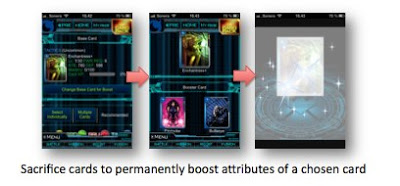
Fusing is combining two of the same cards in order to create a better rare card. Fusing is also something that drives every true card collector to monetize. Seriously, you just can’t emphasize the addictiveness of getting a rare card and realizing that if only you can find another of these rare cards you’ll have a SUPER rare and SUPER powerful card. And, of course, combining two of these SUPER rare cards… you get the point.
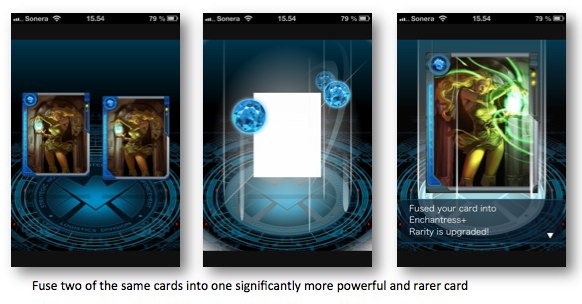
4. Card Packs
There are three ways in which a player can get new cards. As mentioned the initial way is by grinding the PvE Mode and earning one card at a time. The second way is by purchasing card packs and that’s where the monetization seriously kicks in. And the third way is trading with friends players, which is major incentive to get playing friends in the game.
There are only few different card packs priced at different price points but the beauty is in the fact that monetization on cards is based on casino and collector mechanics. Casino in the sense that you just never know what kind of cards the card pack will have. Collector in the sense that you WAN’T to get same cards so that you can fuse them and you WAN’T to get weak cards so that you can use them to boost your chosen cards.
And the beauty from monetization point of view? Well think about it. Players can’t directly buy the cards the really truly want so they have to buy several card packs just and cross their fingers that one of them will have the card they’re looking for. And once they get the card they’re looking for they will most likely search for the second one so that they can fuse these two. Just like kids collecting baseball cards – except that these kids have credit cards and the cards are consumable.
5. The Double Energy Mechanic
There are two different types of energy in Mobage’s card games: PvE and PvP Energy. Both energies have a cap, which can be increased by leveling up and completing PvE quests. In other words, as the player progresses in the game, he’ll have more energy per session due to the increased Energy cap. To restrict the progress, Ngomoco’s card games increase the energy it takes to complete each PvE quest, which at the same time forces player to keep on increasing the max energy cap.
In the end, the way energy mechanics are implemented in all of Mobage’s card games is pretty sweet, as it enables fast progress in the beginning and slows the progress down once the player is hooked. This is because in the beginning the player’s maximum energy levels are very low and thus quickly replenished, but as the game progresses, the player’s maximum energy level will grow and so will the time it takes for energy to be replenished. Slowing down progression is the best way to drive monetization.
6. Looting
From time to time, players receive Treasure (collectible items) when grinding through the PvE quests. Each collectible item is a part of a six piece collection. Once the player possesses all six items in the collection, they will receive a unique card and the collection will be completed. Completed collections transform into the collection reward, while also closing the collection from looting.
Of course, having one rare card is never enough in Ngomoco’s card games as you need at least two cards of the same type in order to fuse them into one super powerful card. So the player is encouraged to finish the collection three times: first collection reward is the card XY, second reward is Bonus and third reward is again the card XY.
What makes grinding collections interesting in Mobage’s card games is the fact that you can steal specific Treasures from other players – and other players will try to steal the Treasures that you posses. The possibility of stealing ends only when a collection has been completed.
The way looting monetizes is amazing:
- Player has to be fast when they set to complete a collection, as people are constantly looking for the Treasures they need at the moment. Being fast means usually buying PvP energy as there’s no time to wait for the energy to reload.
- To loot a Treasure, the player needs to have a strong attack deck. Buying an additional card pack seems like a good investment when you get beaten one too many times.
- To successfully defend their collection while looking for missing pieces, players need to have a strong defensive deck. Buying a card pack sounds like a great idea when your defenses have been defeated over and over again.
- Players can also put a timed defensive shield over the collection items they just looted. When other players try to loot an item protected by a shield, they automatically lose. There’s a custom animation to this kind of battle and it sucks to be on the receiving end. It actually sucks so much that you want to put shields on all of your Treasures, just to make all those players who try to steal from you regret it.
7. Events
To spice up the daily grind, Mobage’s card games introduce various themed events. Events are basically comprised of new PvE missions and a new event-specific card pack in the shop. Players are encouraged to complete these event missions, as the rewards from these missions are new, limited-time resources that can be exchanged for card packs.
To drive the monetization from the events, Mobage adds a timer element (complete missions and collect unique resources before the event is over) and also creates a progress wall in the form of super tough boss fights. Boss fights in PvE are so tough that in order to beat them the player is encouraged to purchase event-specific (and of course limited time) card packs.
8. Teams and Alliances
Need someone to trade cards with? Or how about getting help in a tough boss fight? In case you’re in demand of these two, you can add some team members. The higher your level is, the more team members you can have. And no, you don’t need to send Facebook, Game Center or other “official” requests. Just look at a list of all players and simply send them in-game requests to join your team.
For those seeking a deeper meaning and higher rewards, the Alliance (guilds) is the way to go. Once in Alliance, players start working towards a common cause and can interact with other members of the Alliance. The players’ status in an Alliance is based on how much soft currency they donate to the Alliance. By donating soft currency to the Alliance, players also increase the size of the Alliance. By being a member of Alliance players receive various bonuses (based on what kind of researches their Alliance completes) and get the chance to participate in Alliance vs. Alliance battles.
Conclusion: not a card game but a card collecting game
With Rage of Bahamut, Marvel:War of Heroes, Hell Fire, Blood Brothers and other similar titles, Mobage has succeeded to hook and monetize players around the world.
The success of these titles seems very odd as there’s no stunning graphics, extreme polish or new and exciting gameplay modes. But once you give some time to these games, you’ll understand that their success is based simply on our natural need to collect and compare with other collectors around the world.